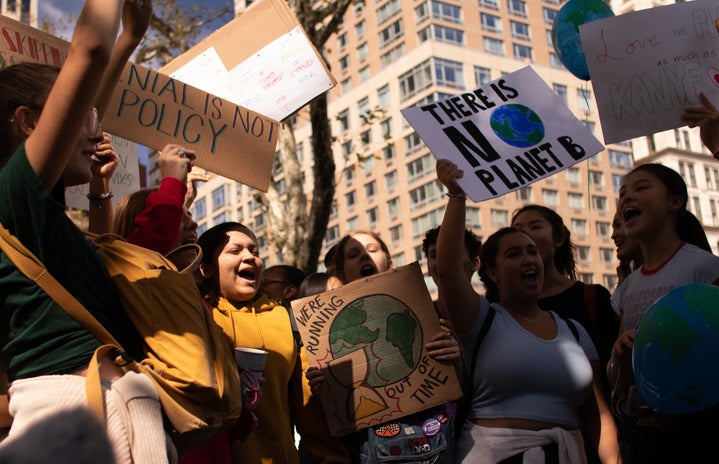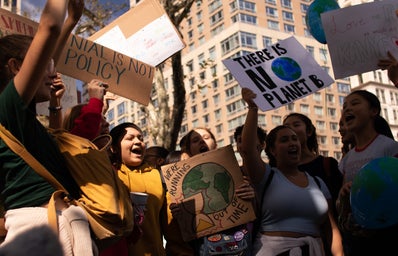With all the concerns about climate change and global warming, many people are warming up (haha see what I did there?) to the idea of finding more sustainable ways to go about our everyday lives. Just this year, Wilfrid Laurier University updated the food disposal system in the Food Court to educate students on proper recycling habits. More recently, the Laurier Bookstore has stopped selling plastic bags and has started encouraging students to bring reusable bags. With the growing awareness of how our actions impact the environment, we can all look for ways to reduce our environmental footprints. Whether you’re dedicated to living sustainably or you’re simply someone trying your best, here are some reusable products that may help you to minimize your waste.
1. Reusable makeup pads
You might be wondering why a makeup product is the first on my list, but I have several justifications for this. First, I figured this product was not very commonly known, and I think it’s so smart that I had to share it first! I actually found out about this product from my younger sister, who ordered some using my Amazon account.
Reusable makeup pads are made out of soft microfibers and can be used as miniature face towels or as a substitute for disposable cotton pads. A really cool part about these little cloths is that they claim to be able to remove makeup with only water, and when they do get a little dirty, they can simply be put in a laundry bag and washed with your regular clothes! With just one product, you can cut out disposable cotton pads and even makeup remover from your grocery list and produce less waste from your daily hygiene routine!
These makeup pads come in packs of 14 and include a laundry bag to wash them in! Click here to be taken to an Amazon page where you can purchase them.
2. Reusable coffee filters
For a lot of university students, life isn’t complete without a daily dose of caffeine. One of the cheapest and most popular ways to make coffee in the morning is with a commercial coffee maker. It’s simple enough: You buy the coffee grounds in bulk, toss them in a filter and allow the machine to create your delicious morning drink. But did you know you could buy reusable coffee filters?
There are many types of reusable filters on the market, and a quick Google search will bring up tons of options! One model is a tight mesh basket that can be inserted into the machine, while other models use a cone-shaped cloth to sift the grounds out of your drink. If you’re more into specialty coffees, reusable K-Cups are also available for Keurig machines! You simply fill the K-Cup with your favorite grounds and use it like a regular K-Cup. When your coffee is complete, clean and refill the K-Cup for future use! Many of these filters can be found online or at your local Canadian Tire.
3. Reusable tea bags
Okay, maybe this one is a bit similar to the last item on this list, but still, we need an alternative for all those tea lovers out there! There are so many cute models for reusable tea bags and tea infusers that you might as well give a try! Some are simply cotton or muslin bags, while others are silicone shapes with little holes in them. These models will allow your loose leaf tea to steep without letting the particles escape into your drink. It’s simple: You buy your favorite tea mixture (or make your own) in a bulk package, then fill your new infuser with it. Now you can just steep the tea as usual and enjoy!
Click here for a cute silicone tea infuser I found on Amazon.
And that’s the tea.
4. Bulk or refillable products
You might be beginning to see a trend here. Another way to purchase sustainably is to buy products in bulk! Bulk products are packaged together in a larger amount than usual, so they use less packaging than individual products. Like I mentioned above, coffee grounds and loose leaf tea all come in bulk packaging and you can use any amount you need as you need it. Bulk purchasing can also be applied to baking and cooking essentials such as flour, salt and sugar. Buying these products in larger amounts means less packaging goes to waste, and you can still enjoy your favorite products. Bulk Barn is a terrific place for purchasing bulk baking supplies, and many grocery stores have a small bulk section.
Another solution is to buy products which can be refilled easily. While this is normally applicable to bulk food products such as salt and pepper shakers, there are also many cosmetic products that can be refilled at a factory or other locations. Many natural soap and hair product brands offer refill stations for their products. One refill centre, Saponetti, allows you to bring any clean container and pay to have it filled with the soap of your choosing, or you can buy a refillable mason jar for under two dollars! It’s an excellent way to keep more plastic out of the recycling bin and to purchase more sustainably.
5. Grocery bags
Although this method has been around for ages, grocery shopping with reusable bags can be really beneficial to the environment. The amount of plastic bags I see drifting in the wind on a cold day is upsetting, and most people just discard their plastic grocery bags after unpacking them. Using reusable bags when grocery shopping is both a cheaper and more environmentally friendly option than buying plastic bags. You can buy reusable bags at nearly any grocery store (I bought some from Dollarama) or you can use a backpack or tote bag from home. To go a step further, you can even buy reusable produce bags online in order to get rid of those clear plastic bags! These mesh bags will help you carry your apples without worrying about plastic, plus they come in a variety of different sizes! A quick Amazon search brings loads of options, but here’s a link to some anyway!
6. Reusable straws
Now with all the discussion going around about marine wildlife and straws, I think it’s worthwhile to mention reusable straws in this list. Straws and other small plastics often get washed into the ocean, where marine life can get tangled and suffocate in the holes. Besides, disposable single-use plastics can be really bad for the environment as a whole. As a result, there is a large movement away from plastic straws and towards alternatives such as paper, silicone, bamboo, stainless steel or other reusable materials. Bubble tea restaurants such as Chatime even sell reusable bubble tea straws, which must have a larger hole for tapioca and other toppings. If you’re interested, straws can be purchased at your local Bulk Barn.
That being said, there are definitely reasons why plastic straws should not be banned, and I want to share some of the reasons these movements may be misguided. Disposable plastic straws can be necessary for a wide variety of reasons. For one, many disabled people rely on straws because they can’t drink otherwise. Compostable straws may melt or break apart, while others may collapse and become a dangerous problem. So while plastic straws may be a good thing to cut out of your lifestyle, many people will be worse off with a complete ban. To learn more about this issue, I suggest watching this YouTube video from Jessica Kellgren-Fozard, who explains why banning plastic straws harms disabled people.
Essentially, do your research before hopping on the bandwagon, but feel free to try out reusable straws!
7. Reusable period products
Another way we can reduce our plastic consumption is by using reusable menstrual products. Although many people use disposable tampons or pads, there are alternatives that can be more environmentally friendly.
One alternative is menstrual cups, which are used internally, similarly to tampons. However, instead of absorbing menstrual blood, the cups collect it. Once full, the cups can then be emptied and washed to be reused again and again! For a one-time cost, it’s a great alternative to use less plastic. In the long term, it’s also cheaper than buying tampons or pads every month. Menstrual cups like the DivaCup can be purchased at your local Shoppers Drug Mart, though there are many more products available online!
Some other alternatives are reusable pads or period underwear such as Thinx brand “period-proof underwear.” Thinx is just one brand that offers period underwear: Underwear made from absorbent fabric which can take the place of pads or tampons, depending on your flow. Another brand, Lunapads, offers washable cloth pads in the place of plastic pads. While less common than the above alternatives, there are also brands developing reusable tampon applicators. The brand DAME offers a reusable tampon applicator that works with all size tampons and can be cleaned and reused. With all this choice, there are many ways to make your time of the month more environmentally friendly!
8. Water bottles
It had to be said. The last item on my list is reusable water bottles! I know this is a product you all know about, but it’s crazy the amount of disposable plastic bottles I see lying around on the ground! It’s so easy to fill up a reusable water bottle on the way to work or school, so I’d like to encourage you to use them! Using a reusable water bottle is much cheaper than buying new plastic bottles, and it’ll keep lots of single-use plastic out of the landfill.
I hope you keep these products in mind as you move forward with your life. With disposable plastics everywhere nowadays, it’s important that we do what we can to minimize our environmental impact! I hope you enjoyed my suggestions and give some of these products a try!



